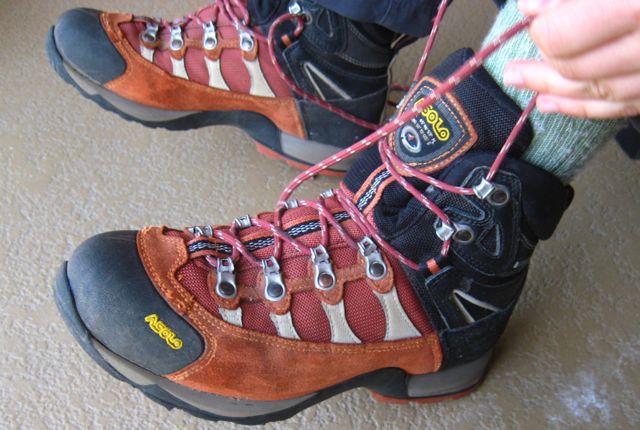I’ve always been a traditional walking boot sort of guy. You know, full blown leather, Gore-Tex liner, a rugged and solid sole. The sort of footwear where your calf muscles strain a little and you notice the weight when you lift your leg up. I like the feeling of security that my feet aren’t going to get wet if my boots are submersed, that my ankles were offered some form of protection and that they looked fit enough for the job.
The only times I went for lighter, low cut, border line running shoes was when I thru-hiked, or in the summer when it was drier. It’s about a personal preference but I think my transition from boot to shoe is pretty much there. In fact, the only time I can really see me using full blown clod hoppers now is winter mountaineering where I can shut off the elements with gaiters when I don’t want snow creeping down into my feet.

Lace up those bad boys but are they too much?!
I feel far more unrestricted when I set off in a pair of trail shoes. They don’t enclose my ankles so I feel a little liberated, the weight is invariably substantially reduced which makes my walking that much more of a pleasure. My feet breathe better in trail shoes, mesh sucks in more air which means I’m more comfortable and nowhere near as sweaty and circulation is improved around the ankles because the air can escape quicker. Shoes flex more, the materials ‘give’ meaning my feet don’t battle against a heavier material such as leather. Most of all, trail shoes just make me feel more nimble, less slave to tradition and with the vast majority of walkers still using boots, our friend the trail shoe is the underdog, and I always support the underdog. Although I still own boots, it’s testament to our friend the lightweight trail shoe that apart from the first half of the Appalachian Trail, both of my American thru-hikes, even taking into account the AT’s reputation for being wet, have been in trail runners.
I walked El Camino de Santiago in leather boots. It was the height of summer; the Gore-Tex reduced my soles to wrinkled, blister ridden minefields. They were all I had, money was tight and I couldn’t afford another pair, they would have to do. My Appalachian miles up to Harpers Ferry were in boots, although these were Inov8 288 GTX’s, incredibly light and flexible. Apart from these instances & perhaps wet and muddy day walks, I now use trail shoes.

Contagrip – No quibbles
There’s a couple of lingering arguments that the Boot Camp still cling onto. Winter mountaineering I’ve already mentioned and fair enough, it would be stupid and dangerous to wear anything else. The other is ankle protection and apparently – stability. I buy neither. Manufacturers claim that high boots will protect our ankles and you know what? They’re probably right. However, can anyone remember the last time they ‘knocked’ their ankle on anything when hiking? If I’ve suffered an ankle grazing on both my big thru-hikes then I must have missed it. I don’t buy the stability aspect either. I agree that an ankle enclosed by a boot is probably more stable but this makes your ankles weaker, not stronger. On thru-hikes I roll my ankles several times a week, sometimes so much that I fear I may have broken it. This is not just me; a lot of hikers report the same. The simple fact is that if you wear high cut boots then you’re ankles are actually weaker. Trail shoes leave ankles to fend for themselves, they have no choice but to improve and adapt to the situation, they become stronger because they have to. Ankle rolling is accepted with a shrug of the shoulders and a cocky grin.
There is an unencumbered freedom, a sense of mischief almost, a delight at giving tradition the big finger. Boots work, no doubt about it but change is inevitable. If something is better overall, which I believe trail shoes are, then the transition will happen. The feeling of warming up on a 25 miler, getting up to speed and then coasting along at 3 mph with the occasional playful dip into the 3 to 4 mph area can only be found in trail shoes.
So, let’s have a look at a pair. Kindly sent to me by Salomon, we discussed the pros and cons of thru-hiking and these chaps, the X Ultra GTX’s cropped up as decent looking contenders. I’ve never owned a pair of Salomon’s before, I’ve had some T-Shirts made by them, and one in particular did me proud on the Appalachian Trail but shoes, no. You tend to stick with who and what works best in experience, why change a winning formula? I’ve hiked in Inov8, New Balance, Montrail, Brooks and a few others but Salomon, for some reason has escaped me despite some great reviews from fellow hikers and always glowing reports from magazine tests.

Salomon describes these as a ‘Technical trail shoe with stable chassis, extra protection and GORE-TEX®, ideal for fast hiking on mixed terrain.’ The first area I noticed was the sole, their Contagrip is tried and tested, and the tread pattern is more towards a walking boot than a trail runner. Grip is excellent, I tested these out on a lovely day up on the South Downs, dry but the soil was muddy in places and generally damp, I had no quibbles with feeling secure once my foot was down. The sole is stiff and none too flexible, exactly what is required and any chalky / flinty areas I passed were soaked up without my feet feeling them.
The X Ultra’s weight is around 830gr, depending on size. This is a little heavy for my liking and arguably over the limit for a thru-hike but the construction is far sturdier than the type of shoe I would normally go for. These are not pieces of mesh stitched onto some foam, there’s a feeling of extra security about them. Only time will tell but I like the build quality, the materials chosen and the overall feel. My choice of thru-hiking footwear in the past has resulted in an average pair lasting around 500 miles, by which time either stitching has worked loose and material somewhere is flapping about or soles are finished with. I would expect these to last longer and therefore would forgive the little weight increase. 4 pairs of shoes on average for a thru-hike can prove expensive, if you’re looking at 2 or 3 pairs instead, and on a budget, these could be a great solution and the weight aspect forgiven.

A great day for testing up on The South Downs
The fit around the toe box is too tight for me but this is not a reflection on the Salomons, more my feet which I know are wide. That said, they were better than others and wouldn’t stop me wearing them. The rest of my feet felt securely in place and cushioned. In fact, at days end and straight from the box I pulled in 12 miles without a sore spot anywhere, surely a blinding recommendation for any pair of shoes.
There are 2 areas I was very impressed with. Firstly, the toe rand. This is the section right at the front of a shoe where either a piece of rubber is added or the sole is continued up and over. It’s been thought out well because it covers the whole width of the toes. The amount of toe stubs, particularly on my little pinkies has had me holding one foot or the other whilst stifling a loud whimper on many an occasion because the toe rand was not wide enough to cover my little chaps. The Salomon’s have an excellent rand but more importantly, it’s not superficial, it actually does the job.
The second great aspect to these shoes is the lacing system. Salomons Quicklace set up is nothing new. Having not owned this brand before I haven’t experienced it but it is frankly, genius. Thinner than average laces meet at the top of the tongue and both run through a small plastic lug. They appear the other side in a plastic loop which is pulled through to the correct tension and then locks in place automatically by cinching down on the lug. That’s not all; a nice touch is a little mesh insert at the top of the tongue which provides housing for the lug, keeping it securely ticked away and very neat looking. There’s no tying of laces, a quick pull and off you go and the beauty is that once you’re moving and your feet have warmed up, and subsequently expanded, a little tweak of the lock and you’re all loosened off. I loved it and even now, having only walked for a day in them, feel a little aggrieved when I have to tie up my laces on my other shoes.

Salomon’s Quicklace Setup – Genius
The GORE-TEX® is security if it’s wet. On a thru-hike I wouldn’t miss it if it weren’t there and in the summer it may prove too hot. A good addition for a hike like the Appalachian Trail with high amounts of precipitation but I wouldn’t bother with it on say the Pacific Crest Trail. These are also available without the GORE-TEX® so either way you should be happy. Price wise they’re in the £90.00 area, par for the course and good value.
To summarise, heavier than some but not heavy in their own right. Could well last longer on bigger hikes so the value for money aspect would be worth considering. Comfortable, reassuringly rugged and durable. Good toe protection for once and a genius lace system makes the X Ultra GTX’s a fine proposition. With the GORE-TEX® addition, their potential to last a good distant and good rock adhesion, these could be the ideal choice for the Appalachian Trail. I’d buy them for the lace system alone. Thumbs up.
